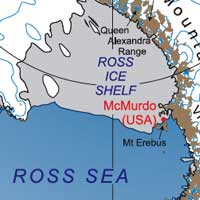Mapping East Antarctica’s Uncharted Territory
WILLIAMS FIELD, NEAR MCMURDO STATION, ANTARCTICA– East Antarctica contains nearly all the world’s supply of fresh water and could contribute hundreds of feet of sea level rise, yet little is known about the stability of this vast ice sheet. In our interview with Jack Holt of the University of Texas at Austin, we learn about a project to chart a glacier in East Antarctica that scientists believe is losing mass. (Video by Lisa Strong-Aufhauser.)
Get the Flash Player to see this player.











I applaud these scientists who brave unbearable weather conditions, isolation, and separation from loved ones in the name of science.
Many of us “non-science” people up here in the NY metro area can’t fathom the potential problems associated with the partial melting of the polar caps. But calculating the volume of ice that would melt if the polar temperatures reach 33 F, and distributing that amount into the surface area of all the worlds oceans, I can’t see the ocean levels raising more than an inch or two. And according to noaa records, the south pole only comes close to 33F a couple days a year. The north pole is just about the same but records a warmer mean temperature still well below freezing.
Let’s all agree that we need to be environmentally aware, but let’s not push the big red button quite yet.
Keep up the good work.
In response to Gary (not that I’m really the one to do so), its more than absolute temperature. Its about the whole mass balance. The temperature can be below 33F, and still have low accumulation relative to ablation (loss). What really matters is the position of the equilibrium line (the position of where ice input and output balance), and for more rapid events, the grounding line (where the ice leaves the ground and floats). Obviously these haven’t led to large sea-level rise historically, but the potential is there for many meters of sea level rise (and ultimately many tens of meters of sealevel rise) irrespective of daily temperature averages.
You’re absolutely right, Nick. The problem is not surface temperature (as in Greenland) but increased melting at the edges due to changes in oceanic currents and subsequent rapid flow of the ice from the center outward. It is a big pile of ice that is thick in the middle, thinner at the edges. Flow is faster where there is smooth bedrock and especially where there is water, so we need to map the bottom of the ice sheet so we can better predict how the ice sheet will respond to increased melting at the edges.
Accumulation is not going to increase in response to increased flow, so the ice sheet will rapidly lose mass (negative mass balance as you pointed out) and that mass goes straight in to the ocean. As for the calculations, Gary, there is approx. 70 meters (over 200 feet) of equivalent sea level rise locked up in the East Antarctic ice sheet. That is not all going to go away, but just ten percent means over 20 feet of sea level rise.